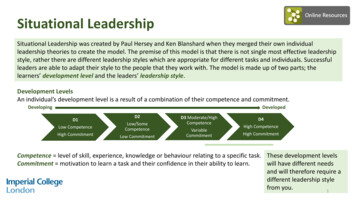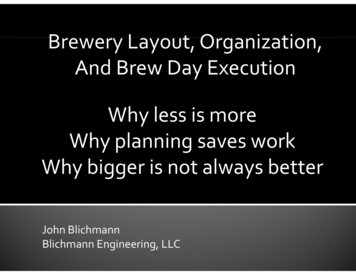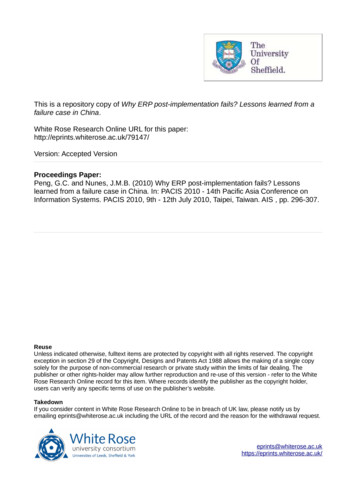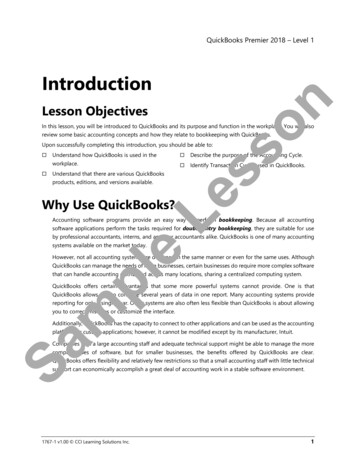
Transcription
PERSPECTIVESWhy a Situational Approachto Leadership MattersThe period from the early 1940s through the late 1950s marked an importantevolutionary time for the concept of leadership. During these two decades,researchers developed and refined several leadership contingency theoriesthat introduced the concepts of initiating structure (the degree to which aleader defines, directs, and organizes his or her role and the roles of followers)and consideration (the degree to which a leader shows concern and respect forfollowers, looks out for their welfare, and expresses appreciation and supportsthem) as distinct leader behaviors that were important for leader success.However, by the 1990s researchers began to view these leader behaviors asoutdated historical artifacts, instead favoring emerging leadership constructslike transformational leadership and full-range leadership. Therefore,consideration and initiating structure began to be viewed as forgottenconstructs in both the academic and commercial literature.But ever since the groundbreaking meta-analysis by Judge, Piccolo, andIlies, there has been a revival in the study of the two traditional leadershipbehaviors: initiating structure (direction) and consideration (support). In theirmeta-analysis, the researchers examined 163 independent correlations forconsideration and 159 correlations for initiating structure; they revealed thatboth consideration and initiating structure had reasonably strong, nonzerorelationships with leadership outcomes. 2017 The Ken Blanchard Companies. All rights reserved. Do not duplicate. MK0851 110617Why a Situational Approach to Leadership Matters1
With the publication of Judge’s work that showed these leader behaviorswere strongly correlated with desirable organizational outcomes, researchinvolving consideration and initiating structure has begun to reappear in thepsychological and leadership literature. And as the research team of SchurerLambert et al. so aptly put it recently, “the abandonment of scholarly interest inconsideration and initiating structure may have been unwarranted.”Historically, there had been very little examination of the interactive effects ofinitiating structure and consideration on employee outcomes. Furthermore,previous research showed few consistent correlations between various impactmeasures and initiating structure and consideration.For these reasons, researchers at The Ken Blanchard Companies embarkedon a research project to build upon the resurgence of studies examiningthe relevance of initiating structure and consideration as effective leaderbehaviors—especially since the two constructs are the foundation fordirection and support, which are the underpinnings of the four leadershipstyles presented in Blanchard’s Situational Leadership II (SLII ) framework andmodel. In this study, we were not testing the validity of the SLII model, but theoutcome resulting from a fit of an individual’s perception of the leadershipstyle that was wanted and the one that was received.The purpose of the study was threefold in its design for investigating thefour leadership styles found in the SLII model, which evolved from initiatingstructure and consideration. We formed three hypotheses:Hypothesis 1: All four leadership styles will be reported as being received by across-sectional survey population.Hypothesis 2: All four leadership styles will be reported as being needed by across-sectional survey population.Hypothesis 3: Followers reporting a fit between their needed leadership styleand the leadership style they received from their manager will demonstratemore favorable scores on selected employee-outcome variables.SLII – An Overview The SLII framework proposes that there are four leadership styles representingdifferent levels of supportive (consideration) and directive (initiating structure)behaviors.The theory designates the four styles as Directing (S1; high directive andlow supportive behaviors); Coaching (S2; high directive and high supportivebehaviors); Supporting (S3; low directive and high supportive behaviors); andDelegating (S4; low directive and low supportive behaviors).2Why a Situational Approach to Leadership Matters 2017 The Ken Blanchard Companies. All rights reserved. Do not duplicate. MK0851 110617
The usage and implications of the four prescribed leadership styles in theSLII model depend on the follower’s development level on a specific task.There are four follower development levels ranging from Developing (D1; lowcompetence and high commitment) to Developed (D4; high competence andhigh commitment).Effective leader behaviors are context-specific, depending on the developmentlevel of the follower on a particular goal or task. The SLII framework proposesthat the leader matches leadership style with the requirements of the situation(development level) to ensure greater performance and satisfaction from theirfollowers.The SLII framework suggests that no single-best leadership style exists; ratherit prescribes that any one of the four leadership styles can be appropriate,depending on a diagnosis of the situation. This leadership frameworkadvocates that leaders change their leadership style depending on thesituation and the person whom they are leading, and, as a result, this modelputs leadership style flexibility at the top of the list for leadership effectiveness.Why This Study Used the SLII ModelWe chose to examine the SLII framework in this study for four reasons. The firstreason is that the framework builds on the models that precede it, and usesthe initiating structure and consideration concepts of the Ohio State studies, asdid other contemporaneous contingency leadership models.SLII, along with the original Situational Leadership theory developed inthe late 1960s by Paul Hersey and Ken Blanchard as well as the Reddin 3-DManagement Style Theory developed in 1969, put initiating structure andconsideration into a quadrant diagram, thereby inviting the exploration ofleadership styles based on the frequent or the infrequent use of the twoleadership behaviors in combination.The SLII model, developed by Ken Blanchard and his associates at The KenBlanchard Companies, reframed initiating structure and consideration asdirective and supportive behaviors. Thus, SLII reflects the rich history andevolution of the initiating structure and consideration constructs.The second reason for using the SLII framework, as noted above, is that theframework offers four styles. The leader styles depicted by the quadrants areprescriptive but not normative. Unlike other grid theories (Blake and Mouton),it does not advocate one style over the others. As mentioned earlier in thispaper, the SLII framework proposes that no single-best leadership style exists,but prescribes that any one of the four leadership styles, depending on a 2017 The Ken Blanchard Companies. All rights reserved. Do not duplicate. MK0851 110617Why a Situational Approach to Leadership Matters3
diagnosis of the situation, could have merit and could be used. As a result,this model puts leadership style flexibility at the top of the list for leadereffectiveness. Because we are proposing in this study an examination of fourdistinct leadership styles generated from combining initiating structure andconsideration, all four styles must be included.The third reason for using the SLII framework is to examine initiating structureand consideration in combination, which has not been frequently studiedin the literature thus far. In previous studies on initiating structure andconsideration (DeRue et al., Judge et al., Schurer-Lambert et al.), the twoconstructs were not empirically combined and analyzed as four distinct leaderstyles. Studying initiating structure and consideration as four styles of leaderbehavior would shed light on the efficacy of the styles.Our study aimed to extend that line of research. Additionally, our studycontributes to a line of empirical research brought forth through theexamination of the “forgotten” constructs of initiating structure andconsideration by using the four leadership styles of the SLII framework derivedfrom the initiating structure and consideration constructs.Fourth and finally, the SLII framework was used because it includes severalassumptions about the combinations of various forms of initiating structureand consideration that need to be tested, regardless of the proposedcontingent-moderating variables of employee development levels.Study Methodology and Measures UsedThe sample used for this study was generated from a database of professionalsworking across various industries. The database is housed and maintained byThe Ken Blanchard Companies. The cross-sectional convenience sample wasmade up of 573 people who chose to participate, a two-percent response ratefrom the full database of professionals who were emailed.Seventy-four percent of participants were from the United States or Canadaand the remainder were from elsewhere in the world (e.g., Asia Pacific, Europe,Africa, Latin America). Thirty-two percent worked for organizations with 500employees or fewer, 30 percent worked for organizations with 500–5,000employees, and 38 percent were from organizations with more than 5,000employees. Fifty-eight percent of the sample were female, and 63 percentwere born after 1960. Approximately 74 percent of the respondents reportedmanaging or supervising others.To identify followers’ needed and received leadership styles from their leaders,as described by the SLII model, scales from the Leadership Action Profile(LAP) were used. In this study, respondents were not given explicit definitionsof supportive and directive behaviors within the context of SLII, nor did theyhave formal knowledge of SLII. Instead, respondents were asked to rate subconstructs of both direction and support (initiating structure and consideration).4Why a Situational Approach to Leadership Matters 2017 The Ken Blanchard Companies. All rights reserved. Do not duplicate. MK0851 110617
Three items on goal setting and three items on showing how were used tomeasure the direction (initiating structure) construct. Three items for facilitatingproblem solving and three items for listening were used to measure the support(consideration) construct on items in subscales provided by the LAP. Alongwith initiating structure and consideration concepts, the respondents wereasked to share their perceptions regarding five organizational work intentions,their positive and/or negative feelings about their work experience, and theirperceptions of cognitive/affective trust in their leader.The Leadership Action Profile. The LAP assessment originates from the SLIIframework and measures how often respondents’ managers demonstratedirective and supportive leadership behaviors. The LAP features 16 subscalesand 50 questions, with six-point response options with anchors ranging from1 (almost never—less than 10 percent of the time) to 6 (almost always—morethan 90 percent of the time). The LAP divides direction and support into 14subscales. The seven micro-behaviors of direction (initiating structure) are goalsetting, planning work in advance, showing and telling how, setting deadlines,setting priorities, defining roles, and defining methods of evaluation. The sevenmicro-behaviors of support (consideration) are listening, rationale building,sharing information about self, sharing information about the organization,facilitating problem-solving, encouraging, and asking for input. LAP alphacoefficients for the total directive and total supportive scales are 0.72 and 0.91,respectively. The higher-order scales of direction and support each are brokendown into four specific behaviors.Because the respondents are asked to rate leader behaviors twice (needed andreceived), a reduction in the total number of items was required to reduce raterfatigue. Goal setting, showing and telling how, listening, and facilitating problemsolving were chosen to represent the dimensions of direction and support.In this study, respondents were asked to rate how frequently their leader exhibited(and they received) goal setting, showing and telling how, listening, and facilitatingproblem-solving leader behaviors described by the LAP in addition to how muchthey wanted (needed) their leader to exhibit each behavior. Thus, respondentsrated each question on the LAP twice, once indicating received leadership behaviorand once indicating needed leadership behavior.The LAP was chosen over the traditional 30-item Leader Behavior DescriptionQuestionnaire (LBDQ) measure because the concept of direction and support,while similar to initiating structure and consideration, has items which areconcerned only with direct interaction with employees in a one-to-one context.A close examination of the LBDQ shows items concerned with both the teamcontext and the one-to-one context, yet are not reported as such. As the fullrange leadership research is sensitive to the limitations of context, we arecorrelating various employee outcomes to employee perceptions of leaderbehaviors; we decided not to complicate the possibilities by including employeeperceptions that would have to be made in both team and one-to-one contexts. 2017 The Ken Blanchard Companies. All rights reserved. Do not duplicate. MK0851 110617Why a Situational Approach to Leadership Matters5
Work Intention Inventory. The five work intentions were measured with theWork Intention Inventory (WII) developed by Nimon, Zigarmi, et al., a 15-itemassessment providing a six-point Likert-type response format, ranging from 1(no extent) to 6 (the fullest extent). The WII has been shown to demonstrategood internal consistency and construct validity. This version of the WII hasthree items representing each of five work intention subscales: intent toendorse the organization, intent to perform, intent to use discretionary effort,intent to stay with the organization, and intent to be an organizational
Do not duplicate. MK0851 110617 Why a Situational Approach to Leadership Matters 1 SCTS Why a Situational Approach to Leadership Matters The period from the early 1940s through the late 1950s marked an important evolutionary time for the concept of leadership. During these two decades, researchers developed and refined several leadership contingency theories that introduced the











